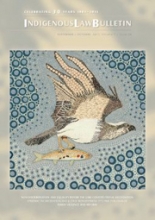September / October 2011 Volume 7 Issue 26

Editorial
Welcome to the September–October Edition of the Indigenous Law Bulletin (‘ILB’). This edition provides a diverse array of articles looking at issues ranging from juvenile justice to constitutional recognition; from the systematic exclusion of Aboriginal people from Alice Springs jury arrays to culture versus gender in the criminal justice system. This edition also addresses the issues of income management and family violence.
Submissions to the Expert Panel on Constitutional recognition havenow closed. However, Shireen Morris keeps the discussion alivewith an article entitled: Indigenous Constitutional Recognition, Non-discrimination and Equality before the Law: Why Reform is Necessary.
In response to the epidemic incarceration rates of Indigenous juvenile offenders across Australia, and in particular Western Australia, Wendy-Rea Young and Tammy Solonec discuss ‘Justice Reinvestment’ as an alternative to imprisoning Indigenous youth, and as an opportunity to improve community safety.
Also in this edition, Russell Goldflam takes us through an analysis of the Full Court of the Northern Territory Supreme Court Case of R v Woods, highlighting the systematic exclusion of Aboriginal people from Alice Springs jury arrays and calling for active steps to remove the practical and regulatory barriers to the performance of jury service by Aboriginal citizens.
Virginia Marshall explores income management in the context of family violence. The article proposes that there should be a flexible and voluntary form of income management offered to people experiencing family violence to ensure that the complex needs of victims are provided for and their safety protected.
In her article Culture versus Gender: How the Mainstream Criminal Court System is Still Getting It Wrong, Elena Marchetti argues that a sentencing process which includes the participation of Elders and Community Representatives, and is thereby more appropriately informed by cultural protocols and knowledge, can result in outcomes which better serve the rights and interests of both victims and perpetrators of family violence. Kylie Cripps, however, argues that Koori Courts are currently falling to adequately serve the rights and interests of victims. See her article: Speaking Up to the Silences – Victorian Koori Courts and the Complexities of Indigenous Family Violence.
We hope you enjoy this edition of the ILB and as always we welcome any feedback you may have.
April Long
Editor
CONTENTS
INDIGENOUS AUSTRALIANS AND THE LEGAL PROFESSION by Alexander Ward
INDIGENOUS CONSTITUTIONAL RECOGNITION, NON-DISCRIMINATION AND EQUALITY BEFORE THE LAW: WHY REFORM IS NECESSARY by Shireen Morris
EPIDEMIC INCARCERATION AND JUSTICE REINVESTMENT: IT’S TIME FOR CHANGE by Wendy-Rea Young and Tammy Solonec
INCOME MANAGEMENT IN THE CONTEXT OF FAMILY VIOLENCE by Virginia Marshall
CULTURE VERSUS GENDER: HOW THE MAINSTREAM CRIMINAL COURT SYSTEM IS STILL GETTING IT WRONG by Elena Marchetti
SPEAKING UP TO THE SILENCES – VICTORIAN KOORI COURTS AND THE COMPLEXITIES OF INDIGENOUS FAMILY VIOLENCE by Kyllie Cripps
THE WHITE ELEPHANT IN THE ROOM: JURIES, JURY ARRAYS AND RACE by Russell Goldflam
Archives of the ILB from Volume 1, Issue 1 (1981) to 6 (27) 2007 are available online at
http://www.austlii.edu.au/au/journals/AboriginalLBand http://www.austlii.edu.au/au/journals/ILB.
